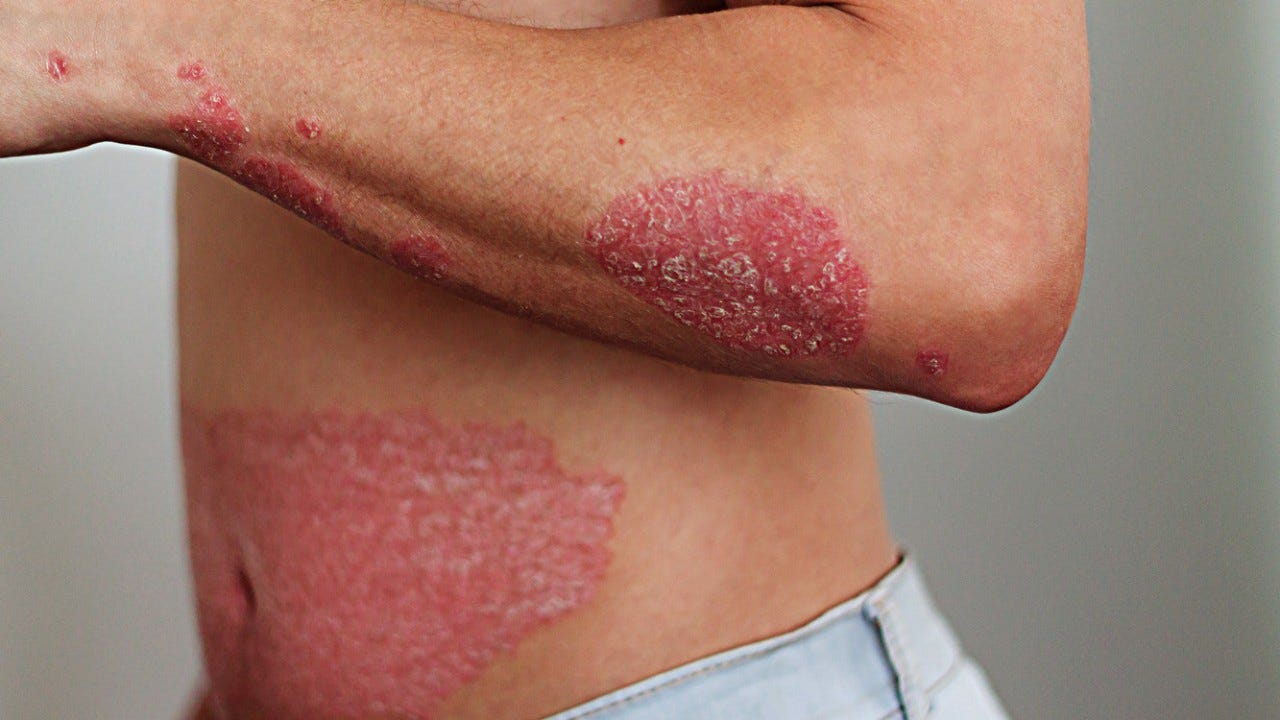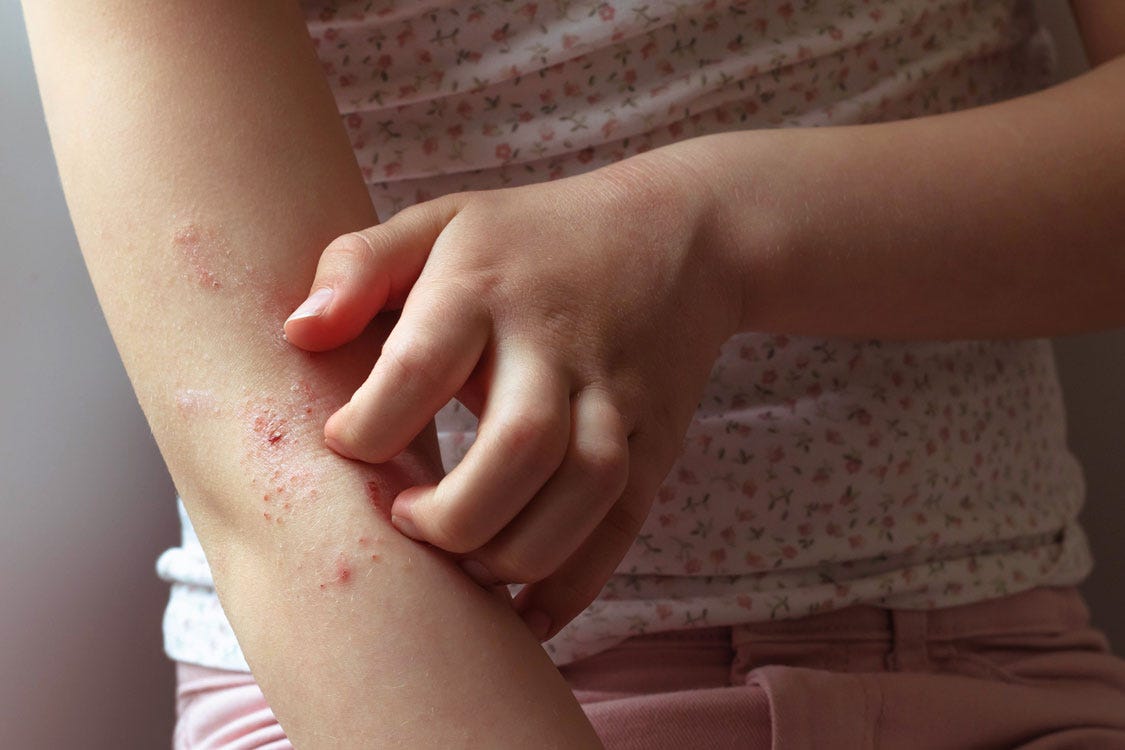Skin diseases: types, symptoms and causes
Our skin isn’t just the body’s biggest organ, it is also one of the most sensitive. Find out more about common skin diseases, how to recognise them and what helps.

What are the most common skin diseases?
Our skin reacts to external stimuli, internal changes, infections or genetic predispositions. And the types of skin diseases are equally diverse. Some are caused by viruses or fungi and are infectious, while others are inflammatory, chronic or genetic.
“As well as being a visual indicator of what’s happening in our immune system, our skin is important for social interaction,” says professor Thomas Kündig, Director of the Department of Dermatology at Zurich University Hospital. “That’s why skin diseases have an effect that goes far beyond the physical – they can stigmatise and be mentally draining.»
Non-infectious skin diseases
-
Acne
Acne vulgaris is the most common skin disease worldwide. “It is triggered by a hormonally controlled overproduction of sebum and a keratinisation disorder of the sebaceous gland ducts,” explains Kündig. This leads to the formation of comedones (blackheads), which can become inflamed by bacteria, causing papules, pustules or lumps.
The face and back are mainly affected. In mild cases, topical preparations such as vitamin D derivatives or benzoyl peroxide are sufficient. “As soon as there is a risk of scars, the acne should be treated systemically – for example with isotretinoin, which is very effective but strictly prohibited during pregnancy,” warns Kündig.
Severe special forms, such as acne conglobata or hidradenitis suppurativa, require specialised systemic treatment – in some cases with biologics that specifically inhibit the inflammatory reaction.
-
Neurodermatitis (atopic eczema)
This common chronic inflammatory disease affects over 10% of children in Switzerland and is closely linked to allergies. “The immune system is skewed towards a TH2 response, which weakens the skin barrier,” explains Kündig. Allergens, germs and irritants penetrate more easily – creating a vicious circle of inflammation and itching.
Good skin care with pH-neutral, moisturising products is essential. Cortisone preparations can help locally – modern cortisone variants are well tolerated and no longer make the skin “thin”. “Cortisone-free preparations with calcineurin inhibitors are available for sensitive areas such as the face,” says Kündig.
In severe cases, biologics or JAK inhibitors, which specifically dampen the TH2 immune response, help today. “This can significantly improve patients’ quality of life.”
-
Psoriasis
Psoriasis affects around 3% of the population and is more than a skin disease. “It is an inflammatory disease characterised by the overproduction of interleukin-17, a neurotransmitter that massively accelerates skin renewal,” says Kündig. This causes red, scaly patches, often on the elbows, knees or scalp that are usually very itchy.
One third of those affected also develop psoriatic arthritis, which affects joints and tendons. Psoriasis is also often associated with obesity, diabetes and cardiovascular disease. Psoriasis is therefore now recognised as a systemic disease, meaning it affects the entire body, not just the skin.
Local treatments with vitamin D3 or cortisone can help with mild cases. More severe forms are treated using modern antibodies that block specific cytokines like IL-17, IL-23 or TNF-alpha. “These treatments are expensive but highly effective – they work on the skin, joints and for systemic inflammation.”
-
Rosacea
Rosacea is a chronic inflammatory skin condition that causes redness, visible blood vessels, and sometimes small, pus-filled bumps. It is caused by hypersensitivity of the vessels and dysregulation of the immune system. Common triggers include sun, alcohol and stress. It is treated with topical creams, oral antibiotics or laser therapy.
-
Urticaria (nettle rash)
Around one in five people will be affected by urticaria once in their life. It is triggered by mast cells that release histamine – partly due to allergens, cold, heat or stress. The welts are extremely itchy, but usually disappear after a few hours.
If the condition becomes chronic (lasting over six weeks), it is often due to an autoimmune cause. Kündig: “In chronic cases, high doses of modern antihistamines can help – or biologics such as omalizumab, which stabilise the mast cells.”
-
Skin cancer
Skin cancer is particularly common in Switzerland. “Malignant melanoma is the most common fatal cancer in young adults in this country,” warns Kündig. Causes include intensive sun exposure and sunburns in childhood.
White skin cancer (basal cell carcinoma, spinalioma) tends to occur more in old age, due to cumulative UV exposure. Modern sunscreens with SPF 50+ block around 99% of UV radiation – but only if they are applied in sufficient quantity.
.
Infectious skin diseases
Infectious skin diseases are usually caused by viruses, bacteria, fungi or parasites and can be easily transmitted on close contact. These infections spread quickly, especially in community facilities, such as schools, gyms or nursing homes.
Many of these diseases are easily treatable, but it is important to detect them early on to avoid infecting others.
-
Athlete’s foot & nail fungus
Both diseases are caused by dermatophytes – fungi that thrive particularly in warm, humid environments such as public showers and gyms. Athlete’s foot often starts between the toes with redness, itching, scaling or blisters,
while nail fungus turns nails thick, brittle and yellowish in colour. Both can be treated with antifungal medication (antimycotics), which can be applied locally or systemically depending on the severity – often over the course of several weeks or months.
-
Herpes simplex
Herpes labialis, commonly known as oral herpes or cold sores, is typically caused by the herpes simplex virus type 1. After an initial infection during childhood, which usually goes undetected, the virus remains dormant in the nerve cells and can be reactivated by stress, exposure to strong UV rays or an immunodeficiency.
It gives rise to tingling, itchy blisters on or around the lips, which form a crust after a few days. Antiviral creams or tablets can only shorten the duration and intensity of the outbreaks a little. Prophylactic treatment with tablets
is recommended for patients who regularly suffer from herpes. -
Head lice
Head lice are wingless insects that are spread through direct head-to-head contact – particularly common among children in schools and nurseries. They lay their eggs (nits) close to the scalp, which causes severe itching.
Treatment involves special lice products (pediculocides), combined with careful combing out of the hair. In addition, bedding, clothing and cuddly toys should be washed or packed airtight for several days.
-
Scabies
Scabies is a contagious skin disease caused by tiny scabies mites. These burrow into the uppermost layers of the skin, where they lay their eggs. Typical symptoms include intense itching at night and fine lines or blisters on the hands, wrists or in the body folds.
Treatment consists of a single application of a cream containing permethrin, which must be left on overnight. Tablets (ivermectin) should also be taken at the same time. People who come into close contact with the patient should also be treated.
-
Anogenital warts & common warts
Anogenital warts (condylomata acuminata) are caused by an infection with certain types of the human papillomavirus (HPV) and are transmitted sexually. They occur in the genital and anal areas and sometimes also appear as soft, cauliflower-like growths that can itch or burn.
A vaccination against HPV provides effective protection against the most common types of pathogens. Common warts on hands or feet are also caused by HPV. They are usually caused by small skin injuries in swimming pools.
. -
Chicken pox (varicella)
Chicken pox is one of the classic childhood diseases, with symptoms that include itchy, fluid-filled blisters all over the body. Symptoms usually appear 10 to 21 days after infection and are often accompanied by a high temperature, malaise and loss of appetite.
The disease is usually harmless, but can be more severe in adults or people with a weak immune system. A vaccination is available and recommended.
-
Measles & rubella
Measles is a highly contagious viral infection, with symptoms including a high temperature, coughing, conjunctivitis and a characteristic skin rash. Complications such as pneumonia or encephalitis are possible.
Rubella is usually milder, but is particularly dangerous during pregnancy as it can damage the unborn child. In both cases, a combined vaccine provides reliable protection in the long term.
When is a skin complaint not an illness?
Not all changes to the skin are pathological. Sunburn, rubbing, insect bites, textiles or hormonal fluctuations can cause similar symptoms. If the symptoms persist or change, you should seek medical advice.
Symptoms of skin diseases
- Redness, inflammation
- Itching – localised or diffuse
- Scaling, dryness
- Blisters, pustules
- Weeping, crusts, open areas
- Changes to moles
- Pain, feeling of tightness
- Thickened or dark areas of skin
- Hair loss, brittle nails
Causes of skin diseases
There are many causes of skin diseases: genetic predisposition, immunological dysfunctions, infections, hormonal fluctuations, medication or environmental factors. “There are often several interrelated causes – as with neurodermatitis, for example, where genetic barrier problems, immune dysregulation and stress come together,” says Kündig. Lifestyle factors such as smoking or lack of sleep also play a role.
Which diseases are hereditary?
- Neurodermatitis: Often familial – especially with allergies
- Psoriasis: There is a clear hereditary factor here.
Can skin diseases be prevented?
Not always, but a lot of factors play a role. Mild cleansing, pH-neutral skincare, sun protection (SPF 50+), a balanced diet and early skin checks help. “And dermatological prevention is particularly worthwhile if you have a family history,” says Kündig.
Skin diseases range from harmless rashes to chronic autoimmune processes. They are visible, often distressing – but today they are almost always treatable. The key is to observe carefully, react in good time, and seek professional help when necessary.



